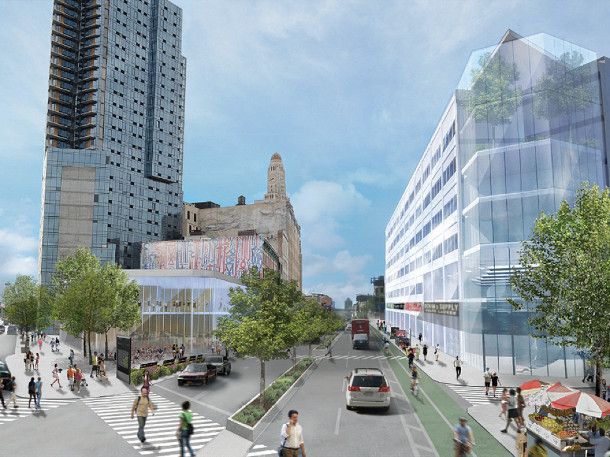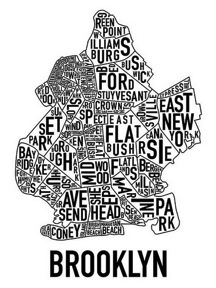
We all know the “garage story” of tech innovation. College dropouts like Bill Gates and Steve Jobs, with too much hair and too little grooming, squirrelled away in suburban, West Coast workshops – usually attached to their parents’ house – where they end up developing the next big thing.Today’s makers take a different approach. Here in the Brooklyn Tech Triangle and throughout New York City, tech companies have been helping neighborhoods flourish because they are choosing to work in collaborative, creative environments. Not in isolated garages, but in shared work spaces, incubators, and creative office buildings.
Their location rationale seems to be driven by basic economic principles: cheaper rent. But this has led to a density of tech companies, resulting in more interaction from competing and complementary firms, as well as community stakeholders, all of which yield numerous spillover benefits. Think meetups in neighborhood bars, increased spending in local stores, and collaboration and resource sharing as in the case of Brooklyn Law School’s recently launched Center for Urban Business Entrepreneurship (CUBE), which offers free legal services for startups, in return securing priceless real-world experiences for their law students.In New York City, tech companies are having an impact, and their actions are resonant. In real estate, the tech sector represented, at 25%, the most leasing activity of all sectors in 2012, according to the NYC Economic Development Corporation, a significant increase from 2002, when the tech sector occupied less than 10% of leasing activity. More importantly, tech fosters innovation and builds ecosystems – manifested bothphysically and socially – that have implications on how we experience the built environment or how we attract quality jobs. Upwards of 500 tech and creative companies have displayed an intrinsic ability to thrive in diverse environments, like the industrial Brooklyn Navy Yard, the neighborhood incubator that is DUMBO, and the 17 million square feet of traditional office space in Downtown Brooklyn.This adaptability is perhaps explained by the world of tech that is diversifying beyond tech behemoths such as Facebook, Google, and Tumblr and demonstrating fledgling, cross-sector, and collaborative character. The Brooklyn Tech Triangle is home to a unique mix of innovation firms, from self-funded startups with fewer than five employees to fast-growing firms. The tech community actively participates in local programming and they are drawn to neighborhood-centric events; some they have founded, others they support like the DUMBO Arts Festival and World Science Festival’s Innovation Square in the MetroTech Commons – which is also home to BAM’s R&B Festival, screenings from Rooftop Films, and at the moment, a stunning sculpture installation curated by the Public Art Fund.
More importantly, tech fosters innovation and builds ecosystems – manifested bothphysically and socially – that have implications on how we experience the built environment or how we attract quality jobs. Upwards of 500 tech and creative companies have displayed an intrinsic ability to thrive in diverse environments, like the industrial Brooklyn Navy Yard, the neighborhood incubator that is DUMBO, and the 17 million square feet of traditional office space in Downtown Brooklyn.This adaptability is perhaps explained by the world of tech that is diversifying beyond tech behemoths such as Facebook, Google, and Tumblr and demonstrating fledgling, cross-sector, and collaborative character. The Brooklyn Tech Triangle is home to a unique mix of innovation firms, from self-funded startups with fewer than five employees to fast-growing firms. The tech community actively participates in local programming and they are drawn to neighborhood-centric events; some they have founded, others they support like the DUMBO Arts Festival and World Science Festival’s Innovation Square in the MetroTech Commons – which is also home to BAM’s R&B Festival, screenings from Rooftop Films, and at the moment, a stunning sculpture installation curated by the Public Art Fund.
To convey the magnitude of the Tech Triangle’s local effect, we commissioned an economic impact study last year which identified nearly 20,000 workers supported by the innovation economy with a collective $3 billion dollar impact on Brooklyn’s GDP. Particularly revealing was the projected demand by existing companies for space to grow. By 2015, innovation economy employees in the Tech Triangle will more than double and occupy approximately 3.1 million square feet. These numbers only reflect companies already operating in the Tech Triangle, not including prospective companies that may move into the area.The clustering of companies in the Brooklyn Tech Triangle has created a momentous demand for neighborhood amenities – like the opportunity to create a 21-acre park stretching from Downtown to the waterfront, increased bus service to serve local residents and workers, or more parochial demos of local products. For instance, as a clean tech innovation demo, local startup BioLite worked with the DUMBO Improvement District to launch DUMBO Firepit, a contained outdoor fireplace that doubles as a phone charging station and lighting source for the neighborhood’s Christmas tree. Equally important are assets such as the Urban Future Lab, NYU-Poly’s clean tech incubator, which will house startups and showcase groundbreaking technology – or the NYU Center for Urban Science and Progress (CUSP), which will be the leading institution in the emerging field of urban informatics, which draws on data to strengthen and improve quality of life in the urban environment, starting with their home in Downtown Brooklyn.Such public goods do not just privilege a handful of tech companies. Rather, they provide far-reaching benefits to all who live, work, and visit the Brooklyn Tech Triangle. And the excitement, pressure, and hopefully resources to realize their vision may not have happened without their presence. In Downtown Brooklyn, we are welcoming them with open arms.

